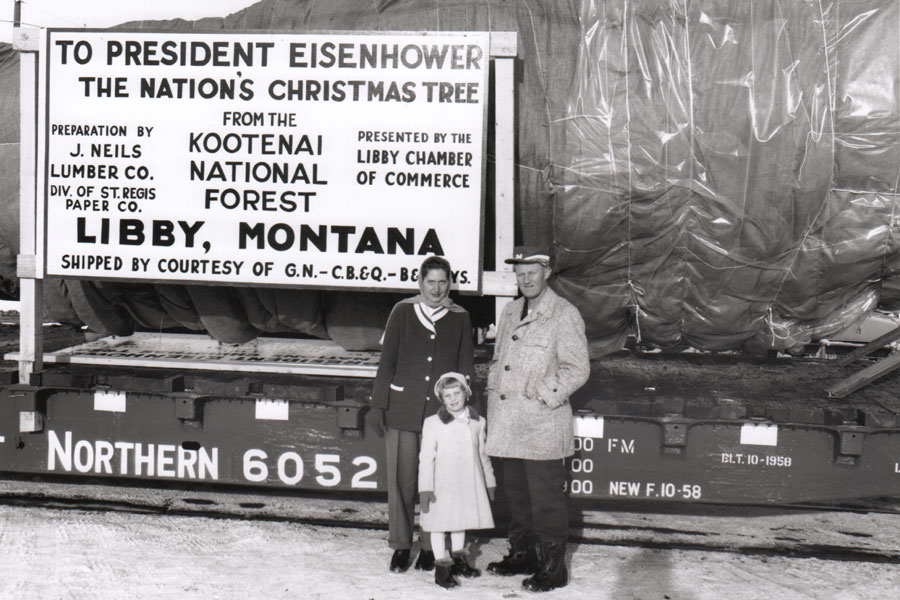Every year since 1970, one of the country’s national forests has been selected to furnish the West Lawn of the U.S. Capitol with a Christmas tree.
This year, the iconic holiday tree will be harvested from the Kootenai National Forest, which has a unique history of providing the nation’s Capitol with its seasonal ambiance.
In 1958, prior to the tradition of the Capitol Christmas Tree’s official beginnings, former President Dwight D. Eisenhower hit the lights on a 75-foot Englemann from the Kootenai during the annual celebration on the White House Lawn, urging international peace.
Then in 1970, the Capitol Architect asked the U.S. Forest Service to begin providing an annual Christmas tree, and ever since a different national forest has been chosen each year to provide the so-called “People’s Tree,” as well as smaller companion trees for government offices in Washington, D.C.
Montana, with its sprawling forested parcels, was a natural choice.
For several decades beginning in the mid-1920s, Lincoln and Flathead counties in particular became known for their colossal annual shipments of Christmas trees to the Midwest, culminating in 1956 at the height of the boom, when 4.2 million Christmas trees were cut in a two-month period in Montana, 80 percent of which came from the northwest corner of the state, according to Darris Flanagan, a retired teacher, historian and writer.
Flanagan has been connected to the tree industry almost since its inception. His maternal grandfather sold trees in the 1930s, and his father began cutting wild Douglas fir in the early 1940s. When he was old enough to pitch in, Flanagan helped with the harvests.
The demand for Montana Christmas trees led to Eureka being nicknamed the “Christmas Tree Capitol of the World,” but the demand began to decline in the 1970s because Douglas fir fell out of favor, as customers were drawn to the more symmetrical, plantation-raised varieties.
Still, in 1989, to commemorate Montana’s centennial, the Kootenai National Forest was selected to provide the U.S. Capitol with its Christmas tree. Capitol Architect Paul Pincus chose a 60-foot Englemann spruce from the Pipe Creek area north of Libby as the People’s Tree.
Bill Crismore, a former state senator and then-president of the Montana Logging Association, as well as the 1983 Montana Lumberman of the Year, was given the honor of chopping down the 60-year-old pine tree.
The second Capitol Christmas Tree selected from Montana was in 2008, when a 78-foot sub-alpine fir from the Bitterroot National Forest made the trip to the Washington.
But the Kootenai still has maintained its edge as the Christmas Tree Capitol of the World.
In July, Superintendent of the Capitol Grounds Ted Bechtol and his staff visited the Kootenai National Forest and inspected a half-dozen candidate trees. After careful consideration, he made his selection – a 79-foot tall Engelmann Spruce, located at the Upper Ford administrative site on the Three Rivers Ranger District near Troy.
With the selection and location of the tree, Forest Service law enforcement officers have been providing 24-hour security of the tree until it is harvested on Nov. 8.
Several events and activities have been planned to observe the 2017 Capitol Christmas tree celebration, including a Nov. 7 open house that will afford members of the public the opportunity to view the tree and take pictures. Refreshments will be provided.
The actual felling of the tree will be a closed event, as space and safety concerns are paramount, according to Sandy Mason, Kootenai National Forest tree project leader.
Drone footage of the tree cutting will be uploaded to Facebook.
The tree will be escorted from its home in the Yaak through the cities of Troy and Libby so the community can see the tree, which will be delivered to the U.S. Capitol grounds Nov. 27 following a 3,000-mile journey.
“This is an honor for the Kootenai Forest to provide the Christmas tree for the Nation,” said Kootenai National Forest Supervisor Christopher Savage. “We’ll look to provide employees and partners to engage in activities and events for the Capitol Christmas tree preparation.”
The journey of the Capitol Christmas Tree includes a series of community celebrations and culminates with the official tree lighting in early December. The tree will make special appearances in towns across the country, including:
Monday, Nov. 13: Eureka and Whitefish
Tuesday, Nov. 14: Libby, Troy and Trout Creek
Wednesday, Nov. 15: Thompson Falls and Missoula
Thursday, Nov. 16: Helena and Great Falls
Friday, Nov. 17: Harlem (Fort Belknap) and Glasgow
Saturday, Nov. 18: Glendive and Dickinson, North Dakota
Sunday, Nov 19: Grand Forks, North Dakota, and Browns Valley, Minnesota
Monday, Nov 20: Kansas City, Missouri
Tuesday, Nov. 21: Springfield, Missouri
Wednesday, Nov. 22: Poplar Bluff, Missouri, and Paducah, Kentucky
Sunday, Nov. 26: Joint Base Andrews, Maryland
Monday, Nov. 27: Delivery to U.S. Capitol
For more information, visit http://www.capitolchristmastree.com/
